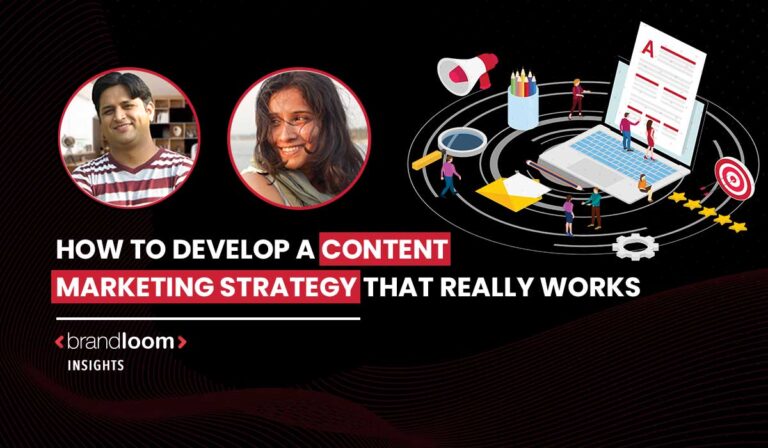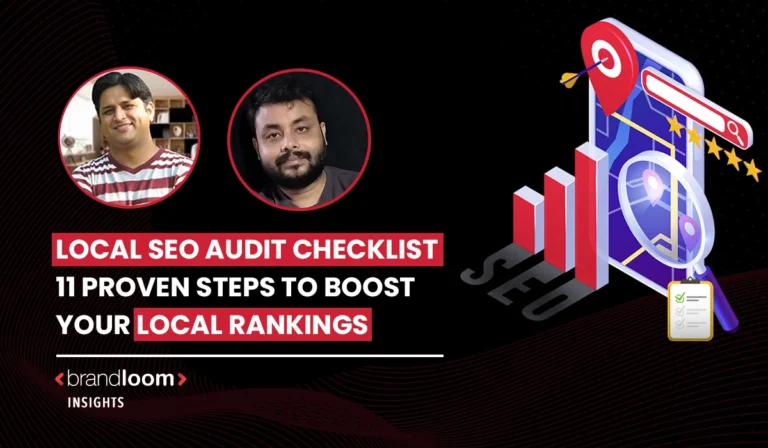Content marketing is a powerful way for businesses to reach their audience through blogs, videos, emails, and more. Knowing how to develop a content marketing strategy is what makes it all work.
Creating content isn’t the hard part. Most businesses are already doing that, for example: writing blogs, posting on Instagram, maybe sending a newsletter now and then. But when nothing seems to work, the real problem shows up: there’s no real plan behind the content.
A lot of teams skip the strategy part. They’re busy, they want quick wins, or they just assume content will work on its own. But without knowing who you’re talking to or what your goal is, even great content can fall flat.
That’s where having a smart strategy makes all the difference. If you want content that gets results and not just noise, it’s time to build a plan that actually works. As a leading content marketing agency in India, at BrandLoom, we help brands do exactly that with clear, goal-driven content marketing strategies. Here’s how to get started.
What Is Content Marketing?
Let’s keep it simple.
Content marketing means making helpful and interesting content that your audience wants to see. This could be blogs, videos, guides, or even social media posts. The main goal is to attract people and keep them coming back.
Here’s the content marketing definition in one line: It’s about sharing useful and steady content to build trust with your audience and turn them into happy customers.
But it’s not just about one post or one video. You need a good content marketing plan. This plan helps you decide what to create, where to share it, and how often. If you do it right, people start trusting your brand. They may even buy your product or sign up for your services.
Want to make the process easier? Use smart content marketing tools like Hemingway Editor and Grammarly. These tools can help you write better, find good topics, and post your content on time.
Content marketing is about helping your audience. If you give them what they need, they’ll stick around and maybe even tell others about you.

Major Forms of Content Marketing
There are many ways to do content marketing. Each one helps you talk to your audience and build trust. Here are some of the most popular types you can start using:
1. Blog Posts
Blogs are a smart way to share ideas. You can write about common questions, trends, or industry tips. This is a great content strategy example because blogs help you show your knowledge, boost your SEO, and connect with readers. Want traffic? Start blogging.
2. Email
Email is still one of the best content marketing tips out there. Why? Because it goes straight to the inbox. Use it to share news, send offers, or give helpful updates. A good email keeps people interested and coming back.
3. Images and Videos
Videos are powerful. People love watching instead of reading. You can show your product, tell a story, or teach something new. Video is one of the most engaging types of marketing content you can use, especially on platforms like Instagram, YouTube, and Facebook.
4. Infographics
Have a lot of data? Turn it into an infographic. These are visuals that explain tough stuff in a fun way. People share them a lot. That means more eyes on your content and more chances to get noticed.
5. Podcasts
Some people like to listen instead of read. That’s where podcasts come in. You can talk about industry trends, interview experts, or share stories. Podcasts help your audience learn while driving or walking. It’s hands-free, easy, and growing fast.
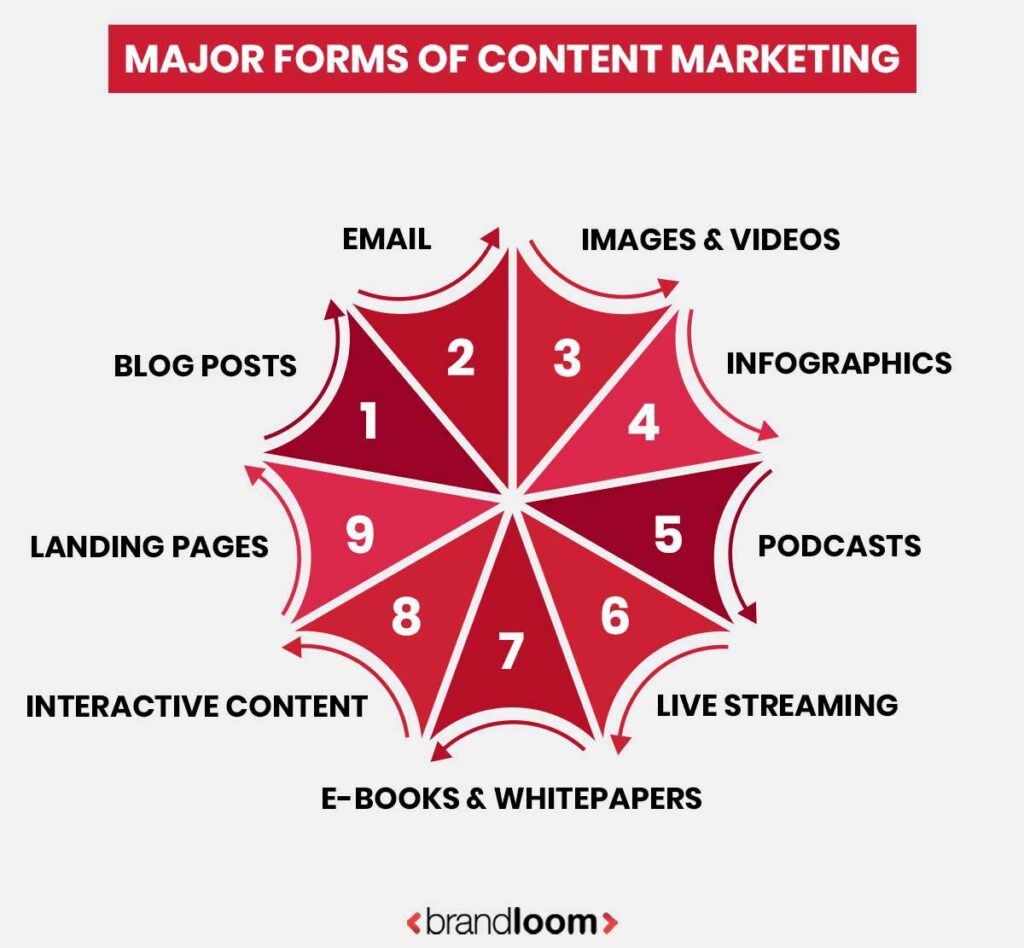
6. Ebooks and Whitepapers
Need to go deep? Ebooks and whitepapers give detailed information. They work best for people who want to learn everything about a topic. hese are great tools for building trust. They’re perfect for B2B brands.
7. Live Streaming
Live streaming is real-time content. You can go live on YouTube, Instagram, or LinkedIn. Use it for product demos, Q&As, or behind-the-scenes events. It’s a great way to talk to your audience and make them feel part of your world.
8. Interactive Content
If you want to boost engagement in a faster way, try interactive content. Use quizzes, polls, or surveys. People love clicking and answering stuff. Plus, you can learn more about your audience while they have fun.
9. Landing Pages
A landing page is a web page designed for a single goal such as generating sign-ups or sales. When someone clicks a link from your ad or email, they land here. A strong landing page shows clear info, strong CTAs, and builds trust. It’s a must-have in any content marketing plan.
What is a Content Marketing Strategy? How to Develop a Content Marketing Strategy?
A content strategy is a plan for how you make, share, and manage your content. It helps you reach the right people and grow your business at the same time.
Let’s say your goal is to get more people to know your brand. You can use content to make that happen. For example, you can write blogs, use SEO, and share helpful stuff online. This makes it easier for people to find you on Google and visit your website.
Your content strategy is also a big part of the buyer’s journey. It helps you attract people and make them happy with what you offer. First, they see your content. Then they learn more. Finally, they trust you and might buy from you.
That’s not all. Marketing and content go hand in hand. Good content also helps your sales team. It gives them the right things to share with people who are ready to buy. And after someone becomes a customer, content keeps them happy. You can answer their questions and teach them how to use your product better.
Now here’s something to remember. Almost 70% of marketers are already putting money into content. So if you want to stay in the game, you need a strong content strategy too.
Start simple. Focus on what your audience wants. Give them value. Keep improving. That’s how content helps your business grow.
Content Marketing Strategy vs Content Marketing
People often mix up content strategy and content marketing. But they’re not the same.
Content strategy is the plan. It’s like a map. It shows you what to create, who it’s for, where to post it, and why it matters. It’s all about planning before you start.
On the other hand, content marketing is the action. It’s when you take the plan and start doing the work, like writing blogs, posting videos, or sending emails. This is how you reach people and grow your brand.
So think of it like this:
- Content strategy = What to do and how to do it
- Content marketing = Doing it and sharing it with the world
Let’s break it down.
1. Purpose
- Content strategy is about planning. It asks questions like:
What should we create? Who are we talking to? What do they need? - Content marketing is about doing. It takes the plan and turns it into action.
It’s the blog post, the video, the newsletter you send out.
2. Focus
- Strategy focuses on the big picture. It sets goals. It thinks long term, for example, like building trust or growing traffic over time.
- Marketing focuses on results like getting clicks, shares, sign-ups, or sales.
3. Timing
- Strategy comes first.
You plan before you start. - Marketing comes next.
You create and share after you have a plan.
4. Tools Used
- For content strategy, you might use research tools, calendars, buyer personas, and analytics. A marketing strategy example can be: you tracking trends and audience behavior.
- For content marketing, you’ll use content marketing tools like Canva, HubSpot, or Buffer. These help you design, write, and publish.
5. Team Roles
- Strategists usually plan the goals, topics, and schedule.
They ask: Why are we making this? - Marketers or creators write, film, design, and share content.
They focus on how to get it in front of the right people.
Here is a simple example: Imagine you run a toy store.
- Your content strategy says:
Let’s target parents looking for educational toys. We’ll post once a week on Instagram and write monthly blogs for our website. - Your content marketing does the work:
You write a blog titled “5 Brain-Boosting Toys for Toddlers” and post it online. You also share a fun toy demo video on Instagram.
| Aspect | Content Strategy | Content Marketing |
| What it is | The overall plan that outlines what content to create, why, and for whom | The actual process of creating, publishing, and promoting the content |
| Main goal | To define clear objectives, understand the audience, and set a direction | To attract, engage, and convert the audience through valuable content |
| When it happens | Comes first, before any content is created | Starts after the strategy is finalized and approved |
| Team | Usually includes strategists, SEO experts, planners, and analysts | Involves writers, designers, videographers, social media managers, and marketers |
| Tools | Strategy maps, editorial calendars, audience research tools, SEO tools | Content creation tools, design software, scheduling platforms, and analytics tools |
How to Develop a Content Marketing Strategy: Why Every Brand Needs a Content Marketing Strategy
A well-planned content marketing strategy is not optional anymore. It’s a must.
Without it, content becomes random. It won’t support business goals, and it won’t reach the right people.
Here are the key reasons why building a strategy is critical for success.
1. Brings Team Focus and Clarity
A solid strategy aligns the entire team. Everyone from writers to designers knows what they’re working toward.
When there’s a clear focus on goals like brand awareness, lead generation, or engagement, it becomes easier to produce content that actually delivers results.
This is one of the most important content marketing strategy goals to keep in mind: unity and clarity across teams.
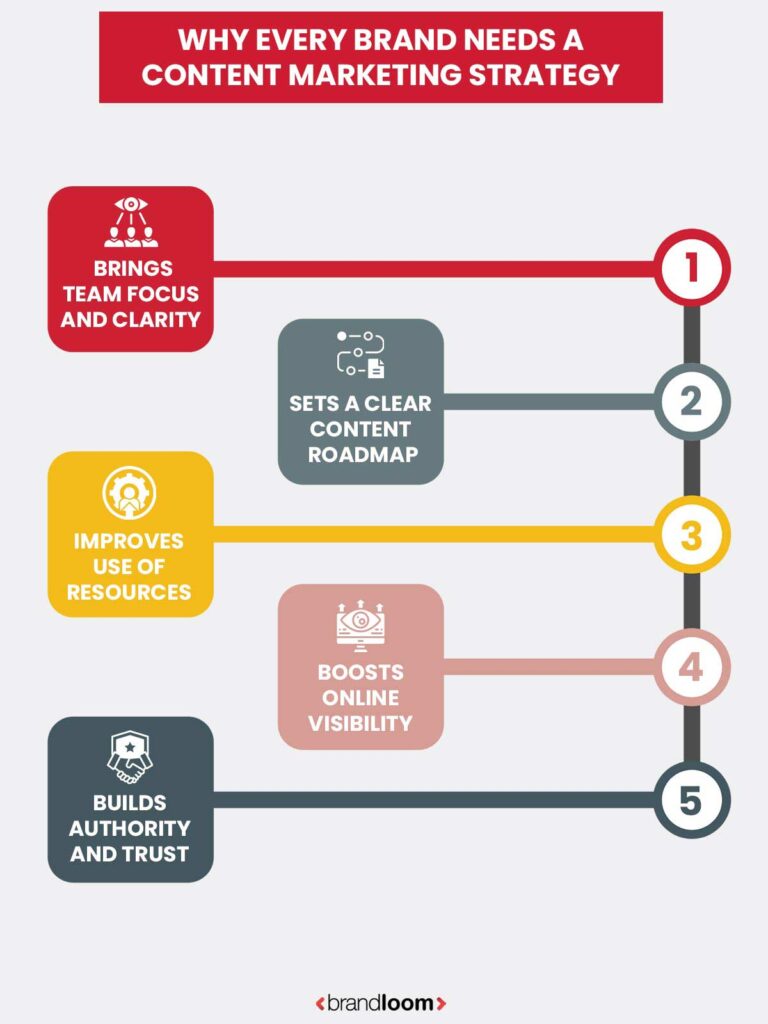
2. Sets a Clear Content Roadmap
A good content strategy development plan answers key questions:
- What type of content should be created?
- Who is it for?
- Where should it be published?
It provides a complete roadmap that guides content creation and distribution.
This makes it easier to produce blog posts, videos, emails, or infographics that connect with the audience.
Consistency and planning are key parts of successful marketing content.
3. Improves Use of Resources
Without a plan, time and budget are often wasted.
But with a full content development strategy, brands can:
- Identify the best platforms
- Choose high-impact content types
- Allocate team time better
The result is a better return on investment. The content reaches more people with less waste.
This is one of the top content marketing best practices that optimize what you already have.
4. Boosts Online Visibility
High-quality content that’s optimized for search engines increases visibility.
A well-planned website content strategy focuses on using the right keywords, topics, and formats to rank better in search results.
The more visible the brand, the more organic traffic it receives. That means more potential leads and more chances to convert.
5. Builds Authority and Trust
Content that teaches, informs, or solves problems builds trust over time.
A consistent content marketing strategy helps a brand:
- Show expertise
- Stay relevant in the industry
- Keep the audience coming back
The more helpful the content, the stronger the connection with the audience. This turns regular readers into loyal followers and buyers.
How to Develop a Content Marketing Strategy: Key Parts of a Strong Content Strategy Plan
A good content plan is like a roadmap. It helps teams know what to create, where to post it, and how to measure success. Whether you’re working on a brand website, social campaigns, or a full b2b content marketing strategy, always start with a strong foundation.
If you’re unsure how to develop a content marketing strategy, just begin here. Start small. Stay clear. Measure what matters.
In case, if you’re wondering how to develop a content marketing strategy, start with these seven core elements.
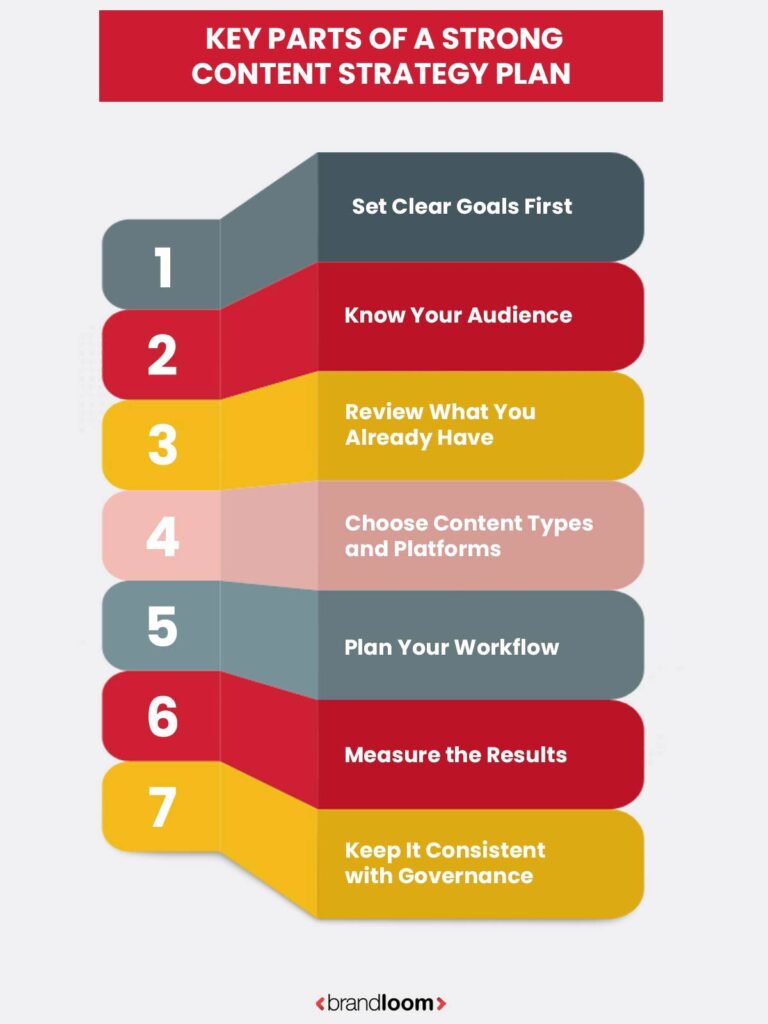
1. Set Clear Goals First
Before you begin, ask: What do we want to achieve?
Do you want to increase brand awareness, drive traffic, or get more leads? Clear goals guide your entire plan.
These goals shape your content strategy in digital marketing. Without them, it’s hard to measure progress or know what’s working.
2. Know Your Audience
Build a profile of your ideal customer. This is called a buyer persona.
To do this, collect data through surveys, feedback, or social media. Learn about their age, job, interests, problems, and what kind of content they enjoy.
Understanding this helps shape your content strategy for inbound marketing, where every piece of content is made for a specific type of user.
3. Review What You Already Have
Before making new content, take a good look at the old.
- What content is working well?
- What’s not getting attention?
- Where are the content gaps?
Use tools like Google Analytics to check performance. This step is key in any content marketing content strategy, especially if you want to avoid repeating past mistakes.
4. Choose Content Types and Platforms
Decide what kind of content you’ll make: blog posts, videos, infographics, or podcasts.
Also, pick where you’ll post it: on your website, social media, email, or all of them.
In content strategy for digital marketing, your content type and platform must match your audience’s habits.
Start small. Test different formats. Then focus on what works best.
5. Plan Your Workflow
This part covers how content gets made. From idea to final post, everyone should know their role.
Use a content calendar to plan topics, dates, and tasks. Such tools can help teams stay in sync.
This is useful for both small brands and large teams building a b2b content marketing strategy where timing and team effort matter.
6. Measure the Results
Once your content is live, track its success.
Use simple tools like Google Analytics or social platform insights. Define your KPIs: clicks, shares, leads, or conversions.
Each goal needs a matching metric. If your goal is traffic, check page views. If it’s leads, check form submissions.
Analytics are a big part of content strategy in digital marketing. They show what to keep and what to improve.
7. Keep It Consistent with Governance
Consistency builds trust. That’s why every content plan needs guidelines.
Set rules for tone, voice, grammar, and design. This way, all your content feels like it came from the same brand, even if made by different people.
This step is often missed but is crucial when scaling a content marketing strategy across teams and channels.
10X Growth in Website Clicks in Just 6 Months : A Case Study on Content Marketing Strategy
The Challenge
A new healthcare service was launched to provide COVID-19 testing for international tourists. Even though they were available at every major hotel, resort, and even the airport, no one could find them online. Their website had zero visibility, and tourists didn’t know where to book a test.
The Goal
The goal was clear: to make the brand visible on search engines and help travellers discover their services easily. That meant showing up on page 1 for every keyword tourists were searching for.
What We Did
BrandLoom started with a full SEO audit. We fixed technical issues and made the website Google-friendly. Then we did keyword research to find high-traffic, low-competition search terms. We built a complete content strategy focused on real questions tourists were asking: like how to get tested, travel rules, and Fit to Fly certificates.
We wrote high-quality blog posts and optimized landing pages. All content was built to rank and drive action.
The Result
Within just six months:
- 10X increase in website clicks from Google
- Average ranking: position 6 on page 1
- Ranked #1 for many key transactional searches
- Surge in website traffic and direct online bookings
- Heavy footfall at airport testing counters
Looking to scale your visibility fast? BrandLoom’s SEO strategy gets real results.
How Content Marketing and SEO Work Together
If you want more traffic and better brand trust, you need two things to work together: content marketing and SEO. One creates the message. The other helps people find it.
A smart brand always includes both when thinking about how to build a content marketing strategy.
Here’s how they help each other:
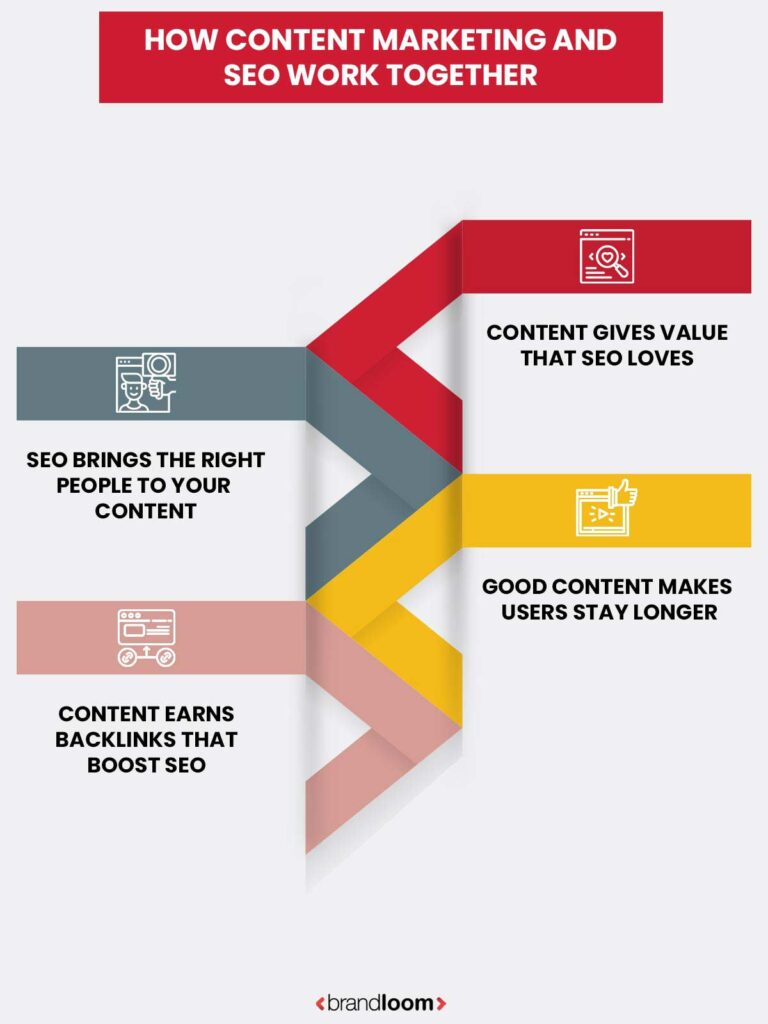
1. Content Gives Value That SEO Loves
Search engines want to show useful content to people.
When you write blogs, guides, or videos that include the right keywords, it tells Google that your website is helpful.
High-quality content, matched with real user questions, is a major part of what makes a successful content marketing plan.
2. SEO Brings the Right People to Your Content
Even the best content is useless if no one sees it.
That’s where SEO steps in.
It helps your blog posts, videos, or landing pages show up in search results when people type in related keywords.
If you’re following a step-by-step content strategy guide, keyword research should be one of your first steps. That’s how you connect your content with the audience who needs it.
3. Good Content Makes Users Stay Longer
Let’s say someone finds your blog from Google.
If the blog is helpful and easy to read, they’ll stay longer. Maybe they’ll read another post or click a link.
The time spent on your site shows search engines that your content is good.
A better user experience = better rankings.
That’s why choosing the best content types for marketing, like blogs, videos, or how-to articles, is so important. Different formats can help keep different users engaged.
4. Content Earns Backlinks That Boost SEO
People like to share great content.
When other websites link to your blog or video, it tells search engines, “This page is worth trusting.”
These links help increase your ranking.
And the best part is you don’t need to ask for them if your content is truly useful.
That’s why every part of your plan, from headlines to visuals, matters when planning how to define goals for content marketing.
If your goal is SEO growth, content must do more than just exist; it must also deserve attention.
Conclusion: How to Develop a Content Marketing Strategy
A strong content marketing strategy isn’t just a nice-to-have, it’s the foundation for real growth. When you know your audience, set clear goals, and create the right content, you start building trust that turns into results. Whether you’re just starting out or trying to fix what’s not working, the key is having a plan that guides every step. If you’re not sure where to begin, BrandLoom can help.
As a trusted content marketing and strategy agency in India, we work with brands to create content that actually connects, converts, and grows. Ready to get started? Let’s build your strategy the right.
Frequently Asked Questions: How to Develop a Content Marketing Strategy
A content marketing strategy is a step-by-step plan that helps you create, share, and manage content to reach business goals. It tells you what to say, who to say it to, and where to say it. Without a plan, content won’t connect or convert.
A content marketing and strategy agency in India like BrandLoom can help you build a strong foundation and choose the right formats and channels to engage your audience and grow your brand.
A good strategy helps you reach the right people at the right time with the right message. It builds trust, drives traffic, and supports long-term growth. Instead of random posting, you work with a purpose. With clear goals and consistent content, brands can see real results.
India’s leading content strategy and marketing partner, BrandLoom, can help you plan, track, and grow your content in a way that supports your overall business goals.
Key components include setting goals, knowing your audience, choosing the right content types, using SEO, and tracking performance. A strong strategy connects your message to the needs of your audience. It keeps your content useful, timely, and engaging.
An online content marketing strategy agency in India like BrandLoom can help you put all these elements together into one clear, action-driven plan that actually works.
Start by thinking about who you want to reach. Look at your current customers, survey them, and check your analytics. Understand their age, job, pain points, and goals.
This helps you create content they care about. With support from a blogging and content marketing strategy agency like BrandLoom, you can create content that truly connects with the people you’re trying to reach.
Start with what matters most: brand awareness, leads, or conversions. Then pick numbers you can track like clicks, shares, or downloads. Be clear and specific so you know what success looks like. Your goals should match your business stage.
If you want content that speaks to your ideal customer, a content marketing and strategy agency in India like BrandLoom can help you map that out clearly.
Choose content types your audience actually uses, for example, blog posts, videos, infographics, or emails. Focus on what solves their problems or answers their questions. It also depends on where they are in the buying journey.
To decide better, start by learning how to create audience personas for content. That way, your content becomes more focused and useful.
A content audit means checking what you already have and understanding what needs to be done. Look at old blog posts, landing pages, or videos. See what worked, what didn’t, and where the gaps are. You’ll know what to keep, improve, or remove.
Use analytics to find top-performing content. Also, follow some basic SEO tips for content marketing to see how well your pages are optimized.
Keyword research shows what your audience is searching for. It helps you plan content around real questions and needs. Focus on keywords with high volume but low competition.
That’s how you create content that gets found. Check out examples of effective content strategies to see how top brands use keyword insights to drive traffic and conversions.
Use tools like Google Analytics, SEMrush, Trello, and HubSpot to manage research, planning, writing, and performance. These help you stay organized, track your goals, and publish on time. You can also use journey mapping tools to see where your content fits. If you want to go deeper, learn how to align content with buyer journey to create better flows and touchpoints.
Track key metrics like traffic, engagement, time on page, bounce rate, and conversions. Use tools like Google Analytics, Search Console, and social media insights. Create a dashboard to watch progress. A content marketing strategy template can also help you stay focused and document everything from goals to outcomes, so you can keep improving based on real data.
Check your content performance every 3–6 months. Update your strategy when business goals change, or when your audience shifts. SEO trends and platform changes can also impact what works. Use reliable tools to plan content marketing in advance and leave room to test new formats or channels. A flexible plan keeps your content fresh and relevant.
Avoid creating content without goals, skipping audience research, ignoring SEO, or posting without a schedule. Don’t try to be everywhere; focus on platforms where your audience is. Also, never copy others without adding your own value. These mistakes cost time and money. A good plan, proper tools, and the right team can help you stay clear of these traps.
Start by setting goals, understanding your audience, and doing keyword research. Pick the right content types and channels. Create a calendar. Write, publish, and measure everything. Adjust as needed. It’s not about creating more, it’s about creating smart. A content marketing and strategy agency in India like BrandLoom can guide you through each step and help you build a strategy that actually works.

